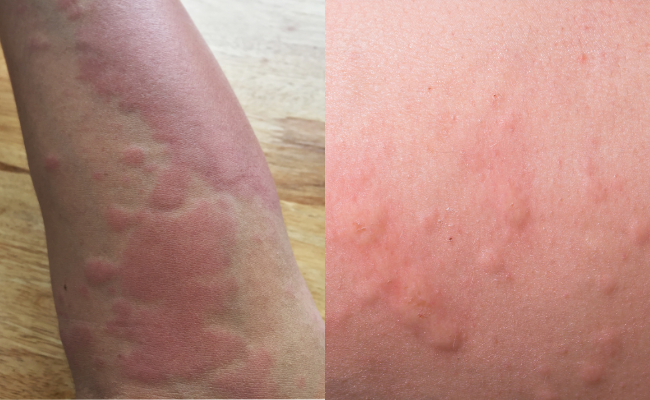How to Treat Hives?
- October 19, 2023
- No Comments

What are Hives?
Hives, scientifically known as urticaria, are raised, red, and itchy welts that can vary in size and shape. These welts, or wheals, emerge suddenly on the skin, causing discomfort and, at times, pain. While often an allergic reaction, hives can also result from stress, infections, or underlying health conditions. They represent a form of surface swelling triggered by an immune system response to allergens—proteins usually harmless to most but provoking an allergic reaction in sensitive individuals. Understanding these triggers is essential for effective management.
Why do Hives Occur?
The occurrence of hives is primarily linked to the release of histamine and other chemicals into the bloodstream. These substances cause small blood vessels to leak, resulting in the characteristic welts on the skin. Common triggers for hives include:
- Allergens: Foods, medications, insect stings, and environmental factors like pollen can trigger an allergic reaction leading to the development of hives.
- Infections: Viral or bacterial infections can stimulate the immune system, leading to the release of histamine and the appearance of hives.
- Stress: Emotional stress is known to contribute to the onset or exacerbation of hives. The body's response to stress can manifest in skin reactions.
- Underlying Health Conditions: Chronic hives may be associated with underlying health conditions such as autoimmune disorders, thyroid problems, or other immune system issues.
How do Hives Affect the Skin?
Hives present as red, swollen welts on the skin that are often surrounded by an area of redness. The appearance of these welts can vary, and they may change shape and location over time. The welts are typically accompanied by itching, ranging from mild to severe. The persistent itching can be distressing and impact the daily lives of individuals dealing with hives.
Treatment Solutions for Hives:
- Identifying and Avoiding Triggers: The first step in managing hives is identifying and avoiding triggers. This may involve keeping a diary to track activities, foods, or environmental factors that coincide with the onset of hives.
- Antihistamines: Over-the-counter or prescription antihistamines are commonly used to alleviate symptoms of hives. These medications work by blocking the effects of histamine, reducing itching, and helping the welts to fade.
- Corticosteroids: In cases of more severe or persistent hives, healthcare providers may prescribe corticosteroids to reduce inflammation and control the immune response.
- Anti-Itch Creams: Topical creams or ointments containing ingredients like calamine can provide relief from itching associated with hives. These can be applied directly to the affected areas.
- Cool Compress: Applying a cool compress to the affected areas can help reduce inflammation and soothe the skin. This is particularly effective for providing immediate relief from itching.
Benefit Points of Hives Treatment:
- Symptom Relief: Effective treatment provides relief from the itching and discomfort associated with hives, significantly improving the overall quality of life for individuals experiencing this skin condition.
- Prevention of Recurrence: By identifying triggers and implementing appropriate measures, treatment helps prevent the recurrence of hives. This is crucial for minimizing the impact on daily life and preventing prolonged discomfort.
- Improved Sleep: Relief from itching allows for better sleep, as nighttime itching can be particularly troublesome and disruptive to sleep patterns.
- Enhanced Emotional Well-being: Managing hives effectively contributes to emotional well-being by alleviating the stress and frustration often associated with recurrent skin reactions. It allows individuals to focus on daily activities without the constant distraction of itching and discomfort.
- Prevention of Complications: Timely and appropriate treatment helps prevent complications and more serious reactions that may occur in severe cases of hives. This includes the development of angioedema, a more severe form of skin swelling that can affect deeper layers of tissue.
Comments (0)